The iPad 2,4 Review: 32nm Brings Better Battery Life
by Anand Lal Shimpi on May 4, 2012 12:50 AM ESTWhen Apple launched the 3rd generation iPad (as the new iPad), it also dropped the price of the entry-level 16GB WiFi iPad 2 to $399. Apple's products tend to hold their values exceptionally well, so this two-tablet strategy made sense. Apple also proved the success of discount-the-previous-gen strategy with its iPhone line, where you can now buy current, n-1 and n-2 generations of iPhones at prices separated by $100.
What's different with the $399 iPad 2 is that Apple used it as a vehicle to introduce a new hardware platform, or more specifically, a new SoC.
The 32nm HK+MG Apple A5 SoC
Prior to the new iPad announcement there were three versions of the iPad 2:
| Apple iPad 2 Lineup | |||||||
| iPad 2,1 | iPad 2,2 | iPad 2,3 | iPad 2,4 | ||||
| A5 SoC | 45nm LP | 45nm LP | 45nm LP | 32nm LP | |||
| Connectivity | WiFi | WiFi + GSM | WiFi + CDMA | WiFi | |||
The 2,1 was WiFi-only, the 2,2 was GSM and the 2,3 was CDMA. The new addition to the family is the iPad 2,4. The 2,4 replaces the original iPad 2,1. It's also only available in a single capacity.
There's no known way to tell whether you're getting an iPad 2,4 vs. the older iPad 2,1 without opening the box. The 2,4 unit I ended up with was made in China, ruling out manufacturing region as a way of telling. The external box looks identical, as does the device itself.

The newer iPad 2,4 units should come with iOS 5.1 preloaded, while any older iPad 2,1 stock may have 5.0.1 or older. But the most accurate way to tell is by looking at what a utility like Geekbench will tell you about the hardware (Update: there are other free utilities that can serve the same purpose, Linpack and Battery Life Pro are two examples):

This particular iPad 2,4 sample came from Best Buy, and several attempts to find one elsewhere came up short. All indications seem to point to the iPad 2,4 being relatively rare, which makes sense considering what's inside it.
Although the iPad 2,1 and its 3G brethren all used a 45nm Apple A5 SoC, the iPad 2,4 uses a die-shrunk 32nm version. The performance remains the same, but the die is much smaller. This isn't however just a normal die shrink, as Apple is using Samsung's 32nm high-k + metal gate LP transistors for this new A5 die. Intel was first to make the HK+MG transition back at 45nm in 2007 and correctly predicted that no one else would make the move until 32nm at the earliest.
Transistors are amazingly complex to fully understand, but at a high level they're quite simple. Imagine a transistor as a silicon based switch. When on, current flows, and when off, current stops flowing. The smaller you make a transistor, the more likely it is to misbehave. If current flows while the transistor is off, you waste power. This is known as leakage current and can come from a number of sources.
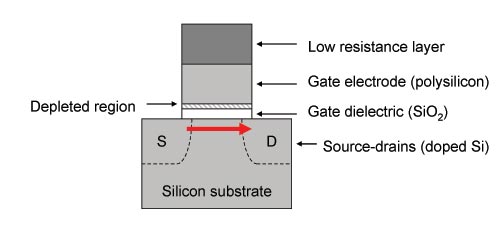
One such source is the gate oxide/gate dielectric, a particularly thin part of modern day transistors - on the order of a handful of atoms thick. Thinning the gate dielectric is desirable up to a certain point, after which the dielectric simply leaks too much power. Switching to a different material here, specifically one with a higher dielectric constant (a higher k-value), can significantly reduce leakage current and mitigate this issue. This is exactly what the first part of Samsung's 32nm high-k + metal gate process does.
The second half of the new process is the introduction of a metal gate electrode. Switching from a polysilicon to a metal gate electrode results in higher drive current by elimination of a region of depleted conducting carriers between the gate electrode and gate dielectric.
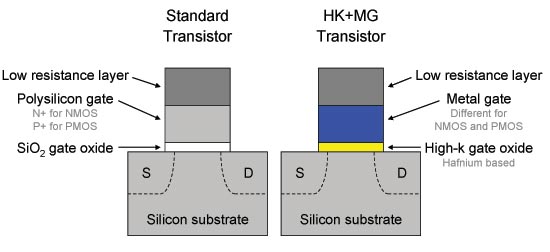
The combination of these two innovations results in less wasted current and more efficient current delivery, which in turn can give us a more power efficient chip. It's a net win. It makes manufacturing more complex, and there's definitely a learning curve to implementing it, but after you get over that hurdle it becomes just another part of the process.
The More Cost Effective Die
Traditionally the move to a smaller process node brings about an increase in transistor density. As transistors get smaller, you can fit more of them into the same space (or the same number into a smaller space). It's this basic principle that makes Moore's Law work. If you can keep shrinking transistor size by about 50% every two years, you'll theoretically be able to double transistor count at the same cost every two years (or cut cost in half every two years). In practice it doesn't work this well. Newer processes are always more expensive than their predecessors initially and logic scaling is never perfect.
It's rare these days that we actually see a pure die shrink anymore. With Intel's tick-tock model we almost always see increases in functionality to accompany each process node shift. In the case of Ivy Bridge, we actually saw a significant increase in transistor count thanks to an improved GPU. With Apple's 32nm A5 however, we truly end up with a die shrunk version of the 45nm A5 SoC. About the only part of the computing world where we see these pure shrinks is in the console space where performance doesn't have to go up within a generation, but cost must go down.
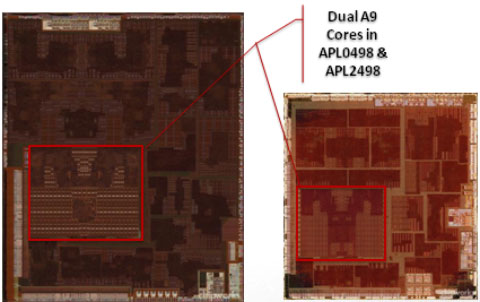
45nm A5 (left) vs. 32nm A5 (right) - Source: Chipworks
The original 45nm A5's die measured approximately 122mm^2. The new 32nm A5 has a surface area of only 69mm^2. That's actually amazingly good scaling at 57% of the old die size, as perfect scaling from 45nm to 32nm would be around 50.5%.
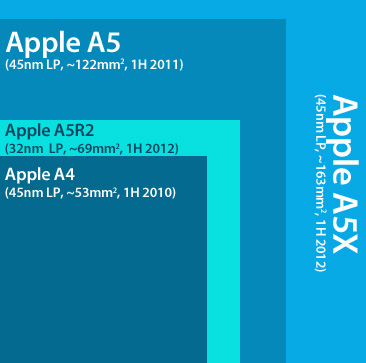
Assuming Apple could make full use of a 300mm wafer (which it can't, wafers are round, chips are rectangular at best so there are some unusable chips), Samsung could deliver 579 45nm A5 die to Apple. The move to 32nm would give Apple 75% more die per wafer at 1015 chips. Again both of these numbers are over estimates as they assume full usage of the surface area of a wafer as well as 100% yields, but you can see the benefit of a smaller die. As long as wafer costs increase by a factor less than the 75% increase in number of die per wafer, Apple can effectively reduce SoC cost by going this route.
These ARM based SoCs are already fairly cheap - all selling well below $30 (many around $15) - so there's not a whole lot of cost savings here. On a product like the $399 iPad 2, where Apple needs to do its best to maintain margins while holding onto (and growing) market share, every last dollar matters.

Gate density vs. process node at Samsung
There's another motivation for Apple however. Just as with any good microprocessor company, its best to introduce a new process technology on a known architecture. It's also a good idea to introduce a new process technology on lower volume products. The combination of both of these minimize risk. Should there be something wrong with the new process, introducing a new architecture on it just means you now have two very complex things to debug - the process technology and the chip's architecture. Should the new process not yield very well initially, you'd be similarly screwed if you were depending on it for your highest volume parts.
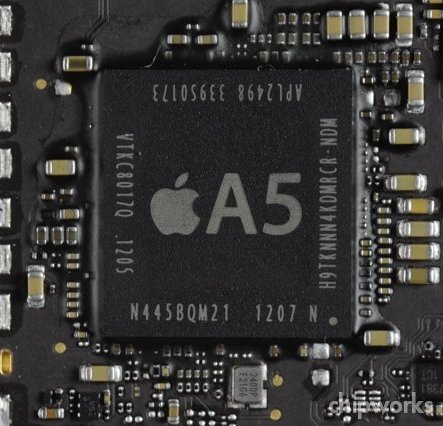
32nm A5 in iPad 2,4 (Source: Chipworks)
Apple decided to try out Samsung's 32nm HK+MG process on the A5 used in the 3rd generation Apple TV and some of the new iPad 2s. The former is a relatively low volume product for Apple, while the latter still moves in significant quantities. To deal with that fact, Apple is continuing to ship the original 45nm iPad 2,1 alongside the new 32nm iPad 2,4. Any hiccups in Samsung's production of the A5 and there are still more than enough iPad 2,1s to go around. The risk of moving to 32nm is effectively mitigated, while the learnings Apple gains from building the 32nm A5 will pay off later this year as Apple ramps up production of a 32nm SoC for use in the next iPhone. It's a very smart strategy, one you would expect from an experienced chip company - not a device vendor. When you consider that Apple employs chip architects who have worked on everything from the Athlon 64 to the Cortex A15, Apple's behavior is no longer that surprising.
Apple gets two benefits from the iPad 2,4: lower manufacturing costs, and experience with Samsung's 32nm HK+MG process which it will later use in much greater volumes. What about customers who end up with an iPad 2,4? Better battery life and cooler operation, of course.

Impact of HK+MG at Samsung
Remember the basics of Samsung's 32nm HK+MG process: a 40% performance improvement at the same leakage, or a 10x reduction in leakage at the same switching speed. As the iPad 2,4 retains the same clocks as the initial iPad 2, the benefit realized is a significant reduction in leakage current. This translates to tangibly better battery life.


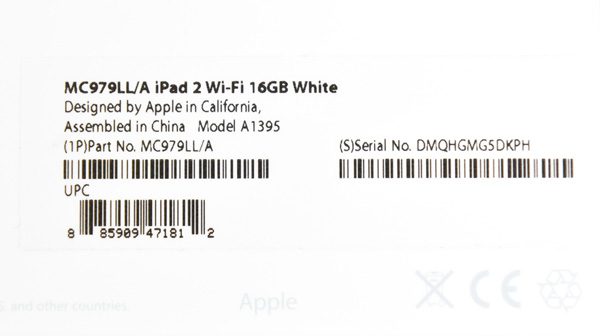








100 Comments
View All Comments
Anand Lal Shimpi - Saturday, May 5, 2012 - link
An update - I didn't feel settled with my response to you so I ran a sanity check against a brand new (never before discharged) 45nm iPad 2 and measured a 2.2% difference between the results (fairly normal for run to run variation) and our iPad 2,1 numbers here.Take care,
Anand
Oxford Guy - Friday, May 4, 2012 - link
"There's no known way to tell whether you're getting an iPad 2,4 vs. the older iPad 2,1 without opening the box. The 2,4 unit I ended up with was made in China, ruling out manufacturing region as a way of telling. The external box looks identical, as does the device itself.To deal with that fact, Apple is continuing to ship the original 45nm iPad 2,1 alongside the new 32nm iPad 2,4. Any hiccups in Samsung's production of the A5 and there are still more than enough iPad 2,1s to go around. The risk of moving to 32nm is effectively mitigated, while the learnings Apple gains from building the 32nm A5 will pay off later this year as Apple ramps up production of a 32nm SoC for use in the next iPhone. It's a very smart strategy, one you would expect from an experienced chip company - not a device vendor."
Sorry, but I call this bad business. It's simply bad business for one customer to get something better than another, due to luck. It's business for people to not know what it is they're getting for their money.
Oxford Guy - Friday, May 4, 2012 - link
Correction: "It's bad business for people to not know what it is they're getting for their money."pixelstuff - Friday, May 4, 2012 - link
It's only bad business if people get something worse than what they think they are getting.Deelron - Friday, May 4, 2012 - link
They're either getting exactly what they paid for or more, I don't see any problem with that.ThreeDee912 - Saturday, May 5, 2012 - link
It's the same thing Microsoft and Sony have been doing with consoles. There are literally dozens of different revisions of the 360 and PS3 with more efficient components in them, with little or no difference in the packaging. It's why Anand referenced gaming consoles in his article.Mrmixor - Sunday, May 13, 2012 - link
Incorrect. Read latest posts! Buy iPad 2,4 at will! Crushes the iPad retina in key areas!Xerazal - Friday, May 4, 2012 - link
Serial number was DMQH98DRDFHW, not sure if that helps.had it exchanged without knowing it was the 32nm model, and now i have the normal ipad 2.. whats weird is that i checked the serial to see when they were both manufactured, and the 32nm ipad 2 was manufactured in March 2012 while the 45nm ipad 2 was manufactured in APRIL 2012. they still make the 45nm one i guess.. either that or this is a 32nm version, but geek bench is showing it as ipad 2 now with A5 processor?
Xerazal - Friday, May 4, 2012 - link
Part numbers are different. at least for black it is. Part number for old ipad is MC769LL/A while new is MC954LL/A. too bad i already exchanged my 32nm ipad out and got the 45nm model as a replacement because of light bleeding on the screen.. T~Tpixelstuff - Friday, May 4, 2012 - link
Is there a weight difference between a 2,1 and a 2,4 tablet? If so then maybe there is a weight difference in the full package.I suppose it is possible there are enough discrepancies in the batteries of an identical iPad model that it could make a weight reading impossible.